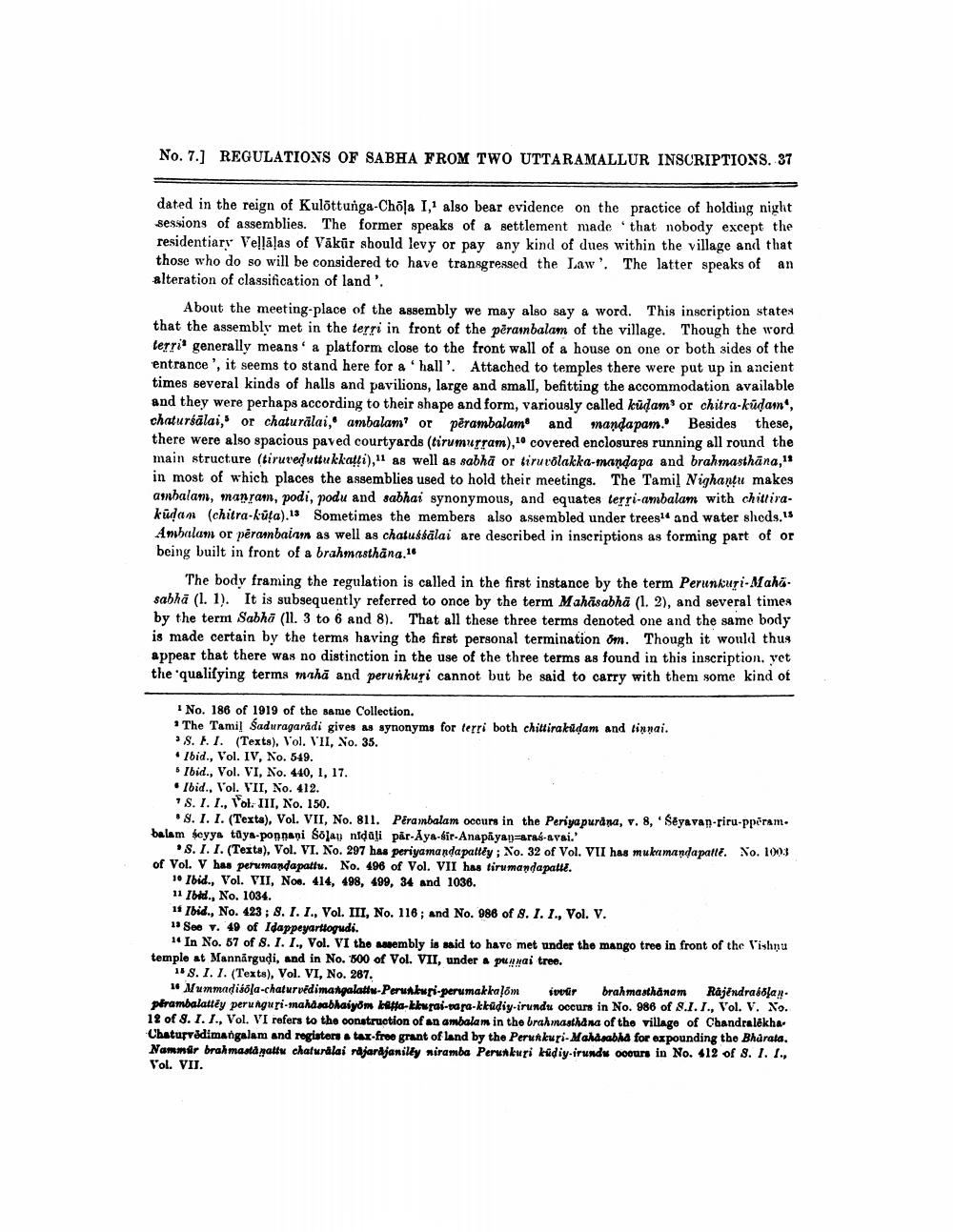________________
No. 7.] REGULATIONS OF SABHA FROM TWO UTTARAMALLUR INSCRIPTIONS. 37
dated in the reign of Kulõttunga-Chöļa 1, also bear evidence on the practice of holding night sessions of assemblies. The former speaks of a settlement made that nobody except the residentiary Veļļāļas of Vākür should levy or pay any kind of dues within the village and that those who do so will be considered to have transgressed the Law'. The latter speaks of an alteration of classification of land'.
About the meeting place of the assembly we may also say a word. This inscription states that the assembly met in the terri in front of the perambalam of the village. Though the word terri generally means a platform close to the front wall of a house on one or both sides of the entrance', it seems to stand here for a 'hall'. Attached to temples there were put up in ancient times several kinds of halls and pavilions, large and small, befitting the accommodation available and they were perhaps according to their shape and form, variously called küdam or chitra-küdam', chatursälai," or chaturälai, ambalam? or perambalam and mandapam. Besides these, there were also spacious paved courtyards (tirumurram), covered enclosures running all round the main structure (tiruveduttukkatti), 11 as well as sabha or tiruvolakka-mandapa and brahmasthāna," in most of which places the assemblies used to hold their meetings. The Tamil Nighantu makes ambalam, manram, podi, podu and sabhai synonymous, and equates terri-ambalam with chittiraküdam (chitra-küta). Sometimes the members also assembled under trees and water shods." Ambalam or pērambaian as well as chatutsälai are described in inscriptions as forming part of or being built in front of a brahmasthāna.16
The body framing the regulation is called in the first instance by the term Perunkuri-Mahā. sabhā (1. 1). It is subsequently referred to once by the term Mahasabha (1.2), and several times by the term Sabha (11. 3 to 6 and 8). That all these three terms denoted one and the same body is made certain by the terms having the first personal termination Om. Though it would thus appear that there was no distinction in the use of the three terms as found in this inscription, yet the qualifying terms mahā and perurikuri cannot but be said to carry with them some kind of
No. 186 of 1919 of the same Collection. · The Tamil Saduragaradi gives as aynonyms for terri both chilltirakudam and linnai. 'S. II. (Texts), Vol. VII, No. 35. • Ibid., Vol. IV, No. 549. 5 Ibid., Vol. VI, No. 440, 1, 17. • Ibid., Vol. VII, No. 412.
S.I.I., Vol. III, No. 150.
.8. I. I. (Texta), Vol. VII, No. 811. Perambalam occurs in the Periyapurana, v. 8, Sêyavan-riru-pperam. balam seyya tiya-ponnani Solay nidali pär-Aya-sir-Anapayap-arab-avai.'
S.I. I. (Texte), Vol. VI. No. 297 has periyamanda pattēy; Xo. 32 of Vol. VII has mukimandapalle. No. 1003 of Vol. V has peru mandapattu. No. 496 of Vol. VII has tirumandapati.
1. Ibid., Vol. VII, No. 414, 498, 499, 34 and 1036. 11 Ibid., No. 1034. 11 Ibid., No. 423 ; 8. 1. I., Vol. III, No. 116 ; and No. 988 of 8. 1. 1., Vol. V. 19 See v. 49 of Idappeyarftogudi.
16 In No. 57 of 8. 1. I., Vol. VI the sembly is said to have met under the mango tree in front of the Vishnu temple at Mannargudi, and in No. 600 of Vol. VII, under pun mai tree.
118. I. 1. (Texts), Vol. VI, No. 287.
Mummadisola-chaturvedimangalattw-Peruskuri-perumakkalom vol brahmasthanam Rajendrabola. ptrambalattéy peru nguri-mahasabhaiyom kira-kurai-sara-kkudiyirundu occurs in No. 988 of 8.1.1., Vol. V. Xo. 12 of 8. 1. I., Vol. VI refers to the construction of an ambalam in the brahmasthana of the village of Chandralekha Chaturvådimangalam and register a tax-free grant of land by the Perunkuri. Mahasabha for expounding the Bharata. Nammir brahmasta mattu chaturdlai ndjardjanilly niramba Perunkuri kudiyirundu ooours in No. 412 of 8. I. I.. Vol. VII.




